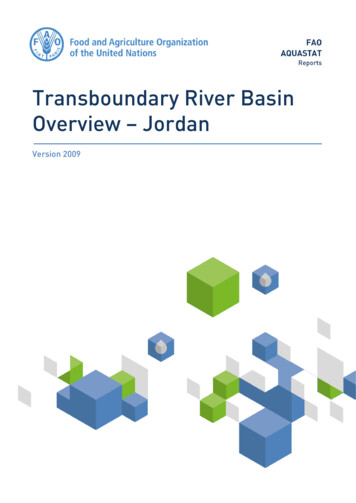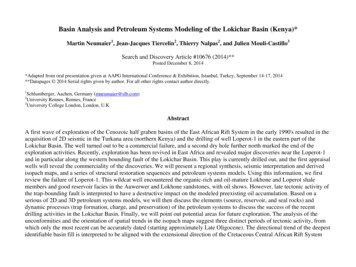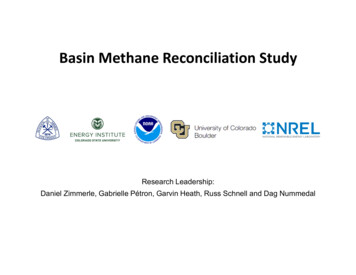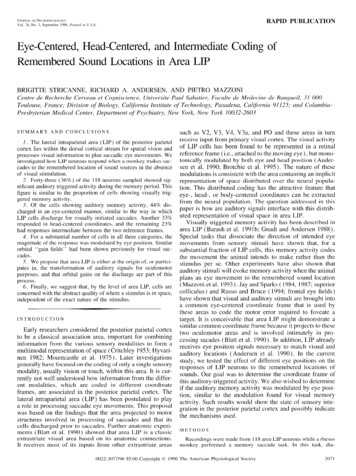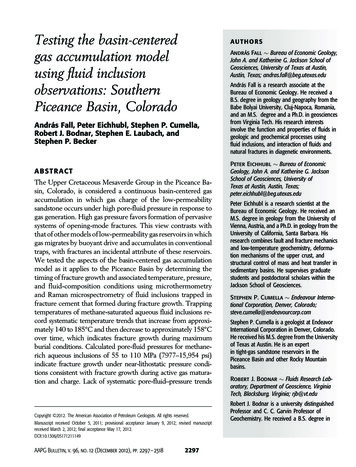
Transcription
Testing the basin-centeredgas accumulation modelusing fluid inclusionobservations: SouthernPiceance Basin, ColoradoAUTHORSAndrás Fall Bureau of Economic Geology,John A. and Katherine G. Jackson School ofGeosciences, University of Texas at Austin,Austin, Texas; andras.fall@beg.utexas.eduAndrás Fall, Peter Eichhubl, Stephen P. Cumella,Robert J. Bodnar, Stephen E. Laubach, andStephen P. BeckerABSTRACTThe Upper Cretaceous Mesaverde Group in the Piceance Basin, Colorado, is considered a continuous basin-centered gasaccumulation in which gas charge of the low-permeabilitysandstone occurs under high pore-fluid pressure in response togas generation. High gas pressure favors formation of pervasivesystems of opening-mode fractures. This view contrasts withthat of other models of low-permeability gas reservoirs in whichgas migrates by buoyant drive and accumulates in conventionaltraps, with fractures an incidental attribute of these reservoirs.We tested the aspects of the basin-centered gas accumulationmodel as it applies to the Piceance Basin by determining thetiming of fracture growth and associated temperature, pressure,and fluid-composition conditions using microthermometryand Raman microspectrometry of fluid inclusions trapped infracture cement that formed during fracture growth. Trappingtemperatures of methane-saturated aqueous fluid inclusions record systematic temperature trends that increase from approximately 140 to 185 C and then decrease to approximately 158 Cover time, which indicates fracture growth during maximumburial conditions. Calculated pore-fluid pressures for methanerich aqueous inclusions of 55 to 110 MPa (7977–15,954 psi)indicate fracture growth under near-lithostatic pressure conditions consistent with fracture growth during active gas maturation and charge. Lack of systematic pore-fluid–pressure trendsCopyright 2012. The American Association of Petroleum Geologists. All rights reserved.Manuscript received October 5, 2011; provisional acceptance January 9, 2012; revised manuscriptreceived March 2, 2012; final acceptance May 17, 2012.DOI:10.1306/05171211149AAPG Bulletin, v. 96, no. 12 (December 2012), pp. 2297–23182297András Fall is a research associate at theBureau of Economic Geology. He received aB.S. degree in geology and geography from theBabe Bolyai University, Cluj-Napoca, Romania,and an M.S. degree and a Ph.D. in geosciencesfrom Virginia Tech. His research interestsinvolve the function and properties of fluids ingeologic and geochemical processes usingfluid inclusions, and interaction of fluids andnatural fractures in diagenetic environments.Peter Eichhubl Bureau of EconomicGeology, John A. and Katherine G. JacksonSchool of Geosciences, University ofTexas at Austin, Austin, Texas;peter.eichhubl@beg.utexas.eduPeter Eichhubl is a research scientist at theBureau of Economic Geology. He received anM.S. degree in geology from the University ofVienna, Austria, and a Ph.D. in geology from theUniversity of California, Santa Barbara. Hisresearch combines fault and fracture mechanicsand low-temperature geochemistry, deformation mechanisms of the upper crust, andstructural control of mass and heat transfer insedimentary basins. He supervises graduatestudents and postdoctoral scholars within theJackson School of Geosciences.Stephen P. Cumella Endeavour International Corporation, Denver, Colorado;steve.cumella@endeavourcorp.comStephen P. Cumella is a geologist at EndeavorInternational Corporation in Denver, Colorado.He received his M.S. degree from the Universityof Texas at Austin. He is an expertin tight-gas sandstone reservoirs in thePiceance Basin and other Rocky Mountainbasins.Robert J. Bodnar Fluids Research Laboratory, Department of Geoscience, VirginiaTech, Blacksburg, Virginia; rjb@vt.eduRobert J. Bodnar is a university distinguishedProfessor and C. C. Garvin Professor ofGeochemistry. He received a B.S. degree in
chemistry from the University of Pittsburgh, anM.S. degree in geology from the University ofArizona, and a Ph.D. in geochemistry andmineralogy from Penn State University. Hisresearch involves the distribution, properties,and function of fluids in Earth and planetarysystems through experimental and theoreticalstudies of fluid inclusions and other geologicand geochemical processes. He supervisesgraduate students within the Department ofGeosciences, Virginia Tech.Stephen E. Laubach Bureau of EconomicGeology, John A. and Katherine G. JacksonSchool of Geosciences, University ofTexas at Austin, Austin, Texas;steve.laubach@beg.utexas.eduStephen E. Laubach is a senior researchscientist at the Bureau of Economic Geology. Hereceived a B.S. degree in geology from TuftsUniversity and an M.S. degree and a Ph.D. ingeology from the University of Illinois atUrbana. He conducts research on fractured andunconventional reservoirs and structural diagenesis. He supervises graduate students withinthe Jackson School of Geosciences.Stephen P. Becker ExxonMobil UpstreamResearch Company, Houston, Texas;stephen.becker@exxonmobil.comStephen P. Becker is a geochemist at ExxonMobil Upstream Research Company in Houston. He received B.S. and M.S. degrees ingeology from the University of Missouri at Rollaand a Ph.D. in geochemistry from Virginia Tech.His research interests focus on the function offluids in basinal environments and applicationsof fluid inclusions to reconstructing basinhistory and fluid properties in hydrocarbonexploration, development, and production.ACKNOWLEDGEMENTSWe thank Michael Dempsey, Jeff Balmer, TimBaer, and T. J. Dewane of EnCana Oil and Gasfor discussions, core access, and permission fordata release. We also thank John Hooker andRob Reed for assisting with scanning electronmicroscopy–catholuminescence imaging, andCharles Farley, with Raman analyses. We thankformer AAPG Editor Ernest A. Mancini forpresiding over the editorial review of this paper.2298over time suggests dynamic pressure conditions requiring anactive process of pressure generation during maximum burialconditions. Such a process is consistent with gas generationwithin the Mesaverde Group or by gas charge from deeper sourcerocks along fracture and fault systems but is inconsistent withsignificant high-pressure generation by compaction disequilibrium during earlier stages of burial. On the basis of a comparisonof trapping temperatures with burial and thermal maturitymodels, we infer that active gas charge and natural fracturegrowth lasted for 35 m.y. and ended at approximately 6 Ma.Our results demonstrate that protracted growth of a pervasivefracture system is the consequence of gas maturation and reservoir charge and is intrinsic to basin-centered gas reservoirs.INTRODUCTIONTight-gas sandstones are a significant unconventional resourcefor natural gas, but their charge mechanisms and the functionof natural fractures during gas charge continue to be debated.Tight-gas sandstones of the Cretaceous Mesaverde Group inthe Piceance Basin, Colorado (Figures 1, 2), have been considered continuous basin-centered gas accumulations (Brownet al., 1986; Johnson, 1989; Law, 2002; Schmoker, 2002; Lawand Spencer, 2004; Cumella and Scheevel, 2008; Cumella,2009). Such a system is characterized by gas-prone sourcerocks and low-permeability reservoirs in close proximity toone another, a lack of downdip water contacts, and gas accumulations that grade vertically across stratigraphic boundaries,forming a continuously saturated gas interval in the deeperparts of the basin (Figures 2; 3A; 4). In the Piceance Basin, thetop of gas is marked by a transition from gas to mixed water andgas and into a gas-free water zone (Figures 3A; 4) (Law, 2002;Cumella and Scheevel, 2008). The primary trapping mechanism in these low-permeability ( 0.1 md; 1 md 10–3 d)rocks is capillary resistance, with generally high capillary entrance pressure at moderate saturation of the wetting phase(Law and Dickinson, 1985; Spencer, 1989a; Law, 2002; Lawand Spencer, 2004). With continued burial and gas generation, the system becomes sufficiently overpressured to overcome the high capillary entrance pressure of the tight matrixand to expel water from the pores, resulting in an overpressuredgas-saturated interval with little residual water. Pore pressuresand pore-fluid–pressure gradients during gas charge are thusexpected to be above hydrostatic.The presence of natural fractures is an important component of the system, providing gas-migration pathways duringBasin-Centered Gas Accumulation, Piceance Basin, Colorado
charge and connectivity between matrix pores, hydraulic fractures, and the wellbore during production (Laubach, 1988,2003; Lorenz and Finley, 1991; Lorenz and Hill, 1994; Cumellaand Scheevel, 2008; Cumella, 2010). High pore-fluid pressuresduring gas generation would favor fracture opening and growth(Olson et al., 2009). Fracture formation would thus be expectedto be contemporaneous with gas generation and charge. Fracture opening and subsequent sealing by mineral precipitationcan provide transient migration pathways and, therefore, dynamic pore-fluid–pressure conditions over time. Regions ofhigher-than-average permeability and production, or sweet spots,have been attributed to the presence of open natural fractures(Surdam, 1997; Laubach, 2003).A different view was put forward by Shanley et al. (2004)and Camp (2008), describing some Rocky Mountain tight-gasreservoirs, such as those in the Greater Green River Basin, aslow-permeability reservoirs in which gas accumulates in subtleconventional stratigraphic and structural traps (Figure 3B), andgas charge is driven primarily by buoyancy. These workerscontended that low-permeability sandstones have uniquepetrophysical properties and that the failure to understandthese properties has led to a misunderstanding of fluid distribution in the subsurface. In a conventional reservoir withgood permeability, water-free gas is produced updip from aninterval in which both gas and water are produced, which inturn overlies free-water production below a gas-water contact. In low-permeability sandstone reservoirs, gas productionis generally restricted to sandstones with water saturations ofless than 50%, and in sandstones with water saturations ofgreater than 50%, the relative permeability to either gas orwater is so low that little to no fluid flow exists (Figure 3B).The term “permeability jail” was coined to describe this phenomenon. Shanley et al. (2004) proposed that this lack of fluidflow in sandstones with higher water saturations has led to themisperception that large areas in the deeper parts of RockyMountain basins are pervasively gas saturated.Cumella (2010) suggested that hydrocarbon columnheights in the discontinuous fluvial sandstone bodies of Piceance tight-gas reservoirs would be insufficient to attainsufficiently high reservoir pressures resulting from buoyancyalone for gas emplacement into the tight pore structure. Forexample, capillary-pressure measurements of Mesaverde gassandstones in the Piceance and other Rocky Mountain basinsindicate that gas columns of several hundred feet to morethan 305 m (1000 ft) are required to reach water saturationsof 40% or less, which are typical of productive sandstones(Byrnes et al., 2009). However, productive sands in the PiceanceWe thank Robert C. Burruss, Thomas Taylor,and Scott Wilkins for their detailed reviews thatsignificantly contributed to the improvement ofthe paper. This study was supported by grantDE-FG02-03ER15430 from the ChemicalSciences, Geosciences, and Biosciences Division,Office of Basic Energy Sciences, Office ofScience, U.S. Department of Energy; the JacksonSchool of Geosciences at the University of Texasat Austin; The GDL Foundation; and by industrysponsors of the Fracture Research and Application Consortium. The publication wasauthorized by the director, Bureau of EconomicGeology, University of Texas at Austin.The AAPG Editor thanks the following reviewersfor their work on this paper: Robert Burruss,Thomas Taylor, and Scott J. Wilkins.EDITOR’S NOTEThis paper was reviewed and accepted bysub-editor Ernest A. Mancini.Fall et al.2299
Figure 1. Well locations and gas fields inthe southern Piceance Basin (modifiedfrom Nuccio and Roberts, 2003, andCumella and Scheevel, 2008). Line AA′corresponds to the cross section inFigure 2.Mesaverde accumulation average a few hundredfeet in width and are typically more than 15 m(50 ft) thick (Lorenz et al., 1985), which is toosmall to allow buoyant force to charge sandstoneswith microdarcy permeability (Cumella, 2010).An alternative explanation for the creation of lowwater saturations is that the gas charge occurredbefore the sandstones reached very low permeability when the capillary forces required to reachlow water saturations were much lower (Shanleyet al., 2007). This explanation proposes that gascharge occurs at shallower burial depths and thatcompaction and cementation degrade permeability to the microdarcy range with continuedburial (Figure 5).This study was designed to test several aspectsof the basin-centered gas accumulation model asit applies to the Piceance Basin. We selected aspects that we consider characteristic to the basin2300centered gas accumulation model and that wouldnot be expected if Piceance Basin tight-gas accumulations formed by buoyant drive in conventionaltraps. In addition, we selected aspects that can betested with fluid inclusion techniques. These aspects include (1) the timing of gas charge andfracture opening relative to the burial and hostrock diagenetic history and (2) the magnitude andhistory of overpressure development in the reservoir during fracture opening. According to Law(2002), gas charge in basin-centered gas accumulations occurs near or at peak burial temperatureand depth conditions. In contrast, followingShanley et al. (2004, 2007), gas charge occurs before peak burial, before porosity is occluded andpermeability is reduced to microdarcy levels. Highpore-fluid pressures are inherent to the basincentered gas model, with high pressures limitedby the fracture gradient. Pressure buildup is thusBasin-Centered Gas Accumulation, Piceance Basin, Colorado
Figure 2. Structural cross section of the Mesaverde Group along line AA′ (Figure 1) (modified from Cumella and Scheevel, 2008). Redcircles are depths of sample locations.expected to be coeval with natural fracture opening. A mechanism for high abnormal pore-fluidpressure and related formation of fractures, or fordynamically varying pore-pressure conditions, isnot inherent in the Shanley et al. (2004) modelbut likely to occur before peak burial during gasmigration into conventional traps. We tested thesehypotheses by fluid inclusion analyses of naturalquartz-cemented fractures sampled in core alongan east-west transect across the southern PiceanceBasin. Fluid inclusions contained in fracture-fillingcement that precipitated during fracture openingwere analyzed by microthermometry and Ramanmicrospectrometry to obtain a history of temperature, pore-fluid pressure, and fluid composition.The relative timing of the fluid inclusion assemblages (FIAs) is constrained by textural mappingof fracture-growth cement zones. This record isthen compared with burial history and thermalmaturity models so as to relate fracture formationand pore-fluid–pressure evolution to burial depthand gas production and charge.We show that the formation of open fracturesis concurrent with gas generation close to the maximum burial depth and under near-lithostatic porefluid pressures. Reservoir charge and fractures coevolved, and open fractures are pervasive attributesof this gas accumulation. This process is consistentwith fracture formation, gas charge, and diageneticporosity loss as persistent and pervasive characteristics of these reservoirs. Our model does not precludethe occurrence of conventional traps, but our findingsare consistent with gas-charge processes commonlyassociated with basin-centered gas accumulations.Fall et al.2301
Figure 3. Simplified models oftight-gas sandstone reservoirs.(A) Direct-type basin-centeredgas accumulation (BCGA)(modified from Law, 2002; usedwith permission of AAPG). (B)Low-porosity conventional trap(modified from Shanley et al.,2004; used with permission ofAAPG).GEOLOGIC SETTINGThe Piceance Basin is an elongate, northwestsoutheast–trending, asymmetric intermontane basin in northwestern Colorado (Figure 1), formedduring the Late Cretaceous and the Paleogene(Johnson and Nuccio, 1986; Johnson and Rice,1990; Cumella and Ostby, 2003; Patterson et al.,2003; Zhang et al., 2008; Cumella, 2009). Theapproximately 1400-m ( 4600-ft)–thick UpperCretaceous Mesaverde Group is composed of theIles and Williams Fork formations (Figure 2). Inthe southern Piceance Basin, the Iles Formationoverlies the marine Mancos Shale and includesthree laterally continuous marine sandstones, theCorcoran, Cozzette, and Rollins members, whichare separated by tongues of Mancos Shale (Figure 2).The Williams Fork Formation is a sequence of nonmarine shales, discontinuous sandstones, and coals2302that were deposited on a coastal plain (Cumella andOstby, 2003; Nelson, 2003b; Cumella and Scheevel,2008).The low-permeability sandstones in the Mesaverde Group contain subvertical natural fractures (Verbeek and Grout, 1984a, b; Pitman andSprunt, 1987; Lorenz and Finley, 1991; Lorenzand Hill, 1994; Cumella and Scheevel, 2008;Hooker et al., 2009). Sampling with vertical anddirection cores shows that fractures are widespread (Lorenz and Hill, 1994; Hooker et al.,2009). The predominant strike of the fractures iswest-northwest–east-southeast, but locally, thestrike changes to east-west in the western part ofthe basin (Pitman and Sprunt, 1987; Lorenz andFinley, 1991; Cumella and Ostby, 2003; Cumellaand Scheevel, 2008). The fractures we describedare mostly open, despite local quartz-cementbridges that contain fluid inclusions. In this, theBasin-Centered Gas Accumulation, Piceance Basin, Colorado
Figure 4. Cross section illustrating a gas-migration model for the Mesaverde Group in the southern Piceance Basin, Colorado (modifiedfrom Cumella and Scheevel, 2008; used with permission of AAPG). Coals and shales in and below the Mesaverde generate gas thatoverpressures the reservoirs, creating a pervasive natural fracture network (small arrows) that allow upward gas migration and formation of a continuous gas-saturated interval. Ovoid shapes represent fluvial sandstone bodies that are pervasively charged below thetop of continuous gas (red color) or are wet (blue color) or partially charged (blue and red colors) above the top of continuous gassaturation. Williams Fork marine sandstone tongues (pink color) are also gas saturated. Migration of highly pressured gas from theunderlying Mancos Shale also likely occurs along major faults. Sandstones adjacent to these fault zones are predicted to be highly gascharged, whereas sandstones in areas of poorly connected fracture systems are inferred to receive lesser gas charge with higher resultantwater saturations.fractures resemble those in many other tightgas sandstones (Laubach et al., 2004a). Locally,quartz-lined fractures are filled with calcite thatwas mostly deposed after fractures ceased opening, again, in a pattern similar to that of manytight-gas sandstones (Laubach, 2003). Fracturesare limited mostly to sandstone reservoirs withoutcrossing into adjacent shale layers because of thedifferences in mechanical properties of the sandstone and shale layers.Several different data sets provide evidenceof a pervasive fracture system in the Mesaverdesandstones. The great disparity between sandstonematrix permeabilities (microdarcys) and reservoirpermeabilities measured by long-term pressuretests of individual Williams Fork sandstone reservoirs (tens to hundreds of microdarcys) is bestexplained by the presence of abundant naturalfractures (Lorenz et al., 1989). Furthermore, diagnostic fracture injection–falloff test data fromFall et al.2303
Figure 5. Different pathways for microdarcy sandstones to reach current water saturations of less than 50%.810 tests showed that 61% of the tests had pressuredependent leakoff, indicating the presence of natural fractures (Craig et al., 2005). Additional evidence of abundant natural fractures is provided bynumerous image logs that have been obtained inthe Piceance Basin in recent years (Koepsell et al.,2003).An extensive test combining wireline logging,borehole seismic, and surface seismic data was recently conducted in the northern Piceance Basinfor seismic characterization of natural fractures(Lewallen et al., 2008). In this study, dipole soniclogs showed that little to no shear-wave anisotropyis measured from the surface to the top of the gassaturated interval. Within the gas-saturated interval, anisotropy in the sandstones is pronounced,ranging from 5 to 20%, whereas anisotropy in theshales never exceeds 5%. The authors propose thatshear-wave anisotropy is controlled primarily by thepresence of natural fractures because shear wavestravel faster parallel to natural fractures than perpendicular to them. The pronounced anisotropywithin the gas-saturated interval and the lack ofanisotropy above it support the model that extensive natural fracturing is associated with gasgeneration. The correlation between the orienta2304tion of fast shear-wave azimuth from the dipolesonic log and the orientation of the natural fractures in the image logs is excellent.Throughout the Mesaverde Group, naturalfractures in core show dominant opening-modedisplacement, with a wide range of aperture sizesof as much as 1.0 cm (0.4 in.) at all depths(Hooker et al., 2009; Hooker and Laubach, 2010)and varying degrees of mineralization. Quartz iscommonly present as fracture cement, although itis not always obvious in hand samples. Calcite andclay minerals are locally prominent (Lorenz andFinley, 1991). For our study, core samples containing quartz cement were collected from thedeeper parts of the Mesaverde Group in the GrandValley (Barrett Energy Company Grand Valley 2Federal, from now on GV2), Rulison (U.S. Department of Energy and CER Corporation core MWX1,from now on MWX1; and U.S. Department ofEnergy and CER Corporation core SHCT1, fromnow on SHCT1), and Mamm Creek (EnCana CoreA, original well name changed because of confidentiality) areas ( 1.09–1.52-mi [1.75–2.45-km], 1676–2438-m [5500–8000-ft] depth interval),corresponding to the lower parts of the WilliamsFork and Iles formations (Figures 1, 2; Table 1).Basin-Centered Gas Accumulation, Piceance Basin, Colorado
FRACTURE CEMENT PETROGRAPHYFigure 6. Photomicrograph and cathodoluminescence imagesof quartz cement in a partly cemented fracture (sample SHCT17360.7 1). (A) Transmitted light; the rectangle corresponds toFigure 7. (B) Scanning electron microscopy–cathodoluminescenceimage. (C) Textural reconstruction of crack-seal cement stages 1to 4 and lateral cement stages L1 to L3. Apparent onlap of lateralcements L2 and L3 over stage 1 crack-seal cements is likelycaused by the sample being cut at an angle to the c crystallographic axis of the euhedral overgrowth cement. Th homogenization temperature.Fractures partly cemented with quartz were impregnated with blue epoxy and prepared as doublypolished 50- to 60-mm–thick sections. Transmittedlight microscopy and scanning electron microscopy–cathodoluminescence (SEM-CL) imaging were usedto examine fracture cement textures. Cathodoluminescence images were obtained using a PhillipsXL30 SEM equipped with an Oxford InstrumentsMonoCL cathodoluminescence system, operatedat 12 to 15 kV and large sample currents for CLimages. Colored CL images were obtained bystacking three grayscale images collected using red,blue, and green filters. Images were adjusted foroptimal color balance, contrast, and saturation during digital image processing.Fractures contain quartz-cement bridges, euhedral quartz cement, and, locally, calcite cement.Quartz-cement bridges are defined as isolated cement occurrences that connect across fracture wallsand that typically grow with the c crystallographicaxis oriented roughly perpendicular to the fracturewalls (Laubach, 1988; Laubach et al., 2004a;Becker et al., 2010). Quartz-cement bridges arecommonly surrounded by fracture porosity or latercement. Similar to quartz-cement bridges describedelsewhere (Laubach, 1988, 2003; Laubach et al.,2004b; Becker et al., 2010), quartz bridges contain an inclusion-rich core surrounded by inclusionpoor lateral cement (Figure 6A). The bridge coreis composed of subparallel trails of fluid and solidinclusions oriented parallel to the fracture walls.We consider these fluid inclusion trails assemblages of cogenetic inclusions (FIAs) (Goldsteinand Reynolds, 1994). Similar fluid inclusion trailsare also observed in some quartz fracture cementthat does not bridge both fracture walls but, instead, terminates into euhedral quartz (rectangleon Figures 6A; 7).High-resolution SEM-CL imaging reveals thatthe inclusion-rich core of quartz-cement bridges iscomposed of multiple subparallel, 1- to 20-mm–wide quartz bands. Stacked transmitted-light andSEM-CL images of cement bridges reveal that thefluid inclusions are in the center of the crack-sealcement bands and that each cement band trappedFall et al.2305
Figure 7. Photomicrograph of coexisting two-phase aqueous(aq) and single-phase gas (g) fluid inclusions in quartz cementshown in Figure 6A. Coexistence of gas-rich and aqueous fluidinclusions demonstrates trapping under gas-saturated conditions.an individual FIA. Some of the cement bandscrosscut previous bands marking sequential growthof cement bands. Fragments of detrital grains contained in bands are parts of broken and detacheddetrital grains observable on the fracture walls(Figure 6B). The multiple parallel cement bands,their mutual crosscutting relations, and the presence of detrital grain fragments among cementbands indicate repeated cycles of fracture openingand quartz precipitation, producing crack-seal texture (Ramsay, 1980; Laubach et al., 2004b). Thiscrack-seal texture indicates that quartz-cementbridges formed concurrently (or synkinematically)with fracture opening. Inclusion-poor lateral cement of quartz bridges lacks crack-seal layers(Figure 6B) but contains idiomorphic growthlayers, suggesting that lateral cement grew intoopen fracture space using the previously formedcrack-seal bridge cement as a substrate.Textural maps of crack-seal cement layers, lateral cements, and their mutual crosscutting relations(Figure 6C) allow interpretation of fracture opening and relative cement sequences (Laubach et al.,2004a; Becker et al., 2010). For example, quartzcement in sample SHCT1-7360.7 1 (Figure 6) initially grew synkinematically across the fracture bycrack-seal mechanism (stage 1 in Figure 6C). Withcontinued growth of crack-seal cement (stage 2 inFigure 6C), lateral idiomorphic cement (L1 in2306Figure 6C) deposited on the early crack-seal cementlayers of stage 1, thus widening the bridge. Succeeding crack-seal increments of stages 2 to 4 cutacross the increasingly wider cement bridge becauseof deposition of lateral cements L2 and, later, L3,resulting in longer crack-seal increments over time(Figure 6C). Subsequent to stage 4, the bridgepictured in Figure 6 detached from the opposingfracture wall, crack-seal cementation ceased, andquartz cementation continued as euhedral fracture cement. We interpret these cement occurrences as bridge fragments or failed bridges.Stacked transmitted light and SEM-CL imagesreveal that the lengths of FIAs parallel to fracturewalls correspond to the lengths of crack-seal cements. Thus, FIAs of crack-seal fracture cementrecord pressure, temperature, and fluid compositional conditions during fracture opening and atime segment of basin evolution.FLUID INCLUSION ANALYSISAt room temperature, FIAs trapped in crack-sealquartz cement contain coexisting two-phase,liquid-rich aqueous inclusions and single-phaseliquid inclusions (Figure 7). The two-phase liquidrich inclusions contain 5 to 10 vol. % vapor andrange from less than 1 to 10 mm in size. The singlephase inclusions are less than 1 to 20 mm in size.Several FIAs containing large (10–30 mm) twophase liquid-vapor inclusions are aligned perpendicular to the crack-seal layers. Based on stackedtransmitted-light and SEM-CL images, we tentatively interpret these inclusions to postdate crackseal cement growth and have not considered themfurther in interpreting the evolution of fractureopening and cementation.Fluid inclusion microthermometry was performed before SEM-CL imaging to avoid possible beamdamage to fluid inclusions. Microthermometric analyses of fluid inclusions were conducted using aFluid, Inc.–adapted, U.S. Geological Survey–type,gas-flow heating-freezing stage mounted on anOlympus BX51 microscope equipped with a 40 objective (numerical aperture [NA] 0.55) and15 oculars. The stage was calibrated using theBasin-Centered Gas Accumulation, Piceance Basin, Colorado
Table 1. True Vertical Depth of Samples, and Type, Homogenization (Trapping) Temperatures, and Trapping Pressures of FluidInclusions in Quartz Fracture Cements in the Southern Piceance Basin, Colorado*Sample NumberTVD** (ft)G**Grand 68.0 2SHCT-9027.5SHCT-9037.3SHCT-9061.85735.6 6900.07904.17904.2 7910.0 7910.0 7910.0Mamm CreekCore A-7746.7Core A-7816.0Core A-7818.8Core A-7819.3Core A-7819.7Core A-8008.97746.77816.07818.87819.37819.78008.9 Aq** G**T ** ( C)T ** ( F)P** (MPa)P** (psi, 1000) 151–172304–34257–788.3–11.3 154–163309–32555–688.0–9.7 8.8–14.29.6–12.5 164–181295–35664–1109.3–16.0 10.9–13.512.0–12.8*Bullet points indicate the presence of the respective fluid inclusion type.**TVD true vertical depth; G gas; Aq aqueous; T temperature;
chemistry from the University of Pittsburgh, an M.S. degree in geology from the University of Arizona, and a Ph.D. in geochemistry and mineralogy from Penn State University. His research involves the distribution, properties, and function of fluids in Earth and planetary systems through experimental and theoretical




